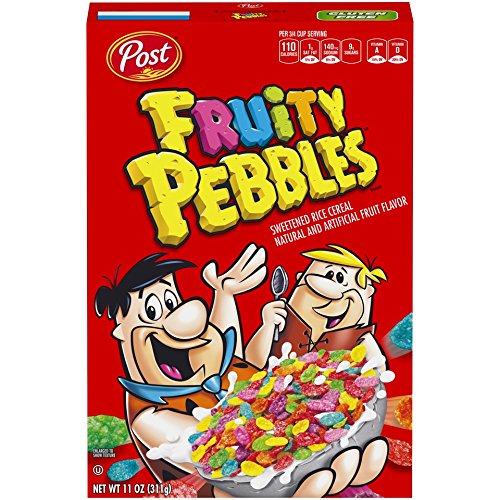Have you had an experience with green poop after eating Fruity Pebbles? Then you are in the right place!
There has been a lot of concern about Fruity Pebbles causing green poop but not all that much information online, so we decided to do a little investigating here at Gut Advisor to get to the bottom of things.
Some people claim to have been experiencing green poop for weeks after switching to a Fruity Pebble diet for their morning breakfast; some mothers have been concerned after seeing unnatural green colors in their child's diapers; and some people have enjoyed as little as one bowl of the tasty cereal only to end up being alarmed on their next trip to the toilet.
It is so common that the term "fruity poop" has been coined for such an occurrence at UrbanDictionary...

It's fairly common. That's a bit relieving... but is there any cause for concern?
After all, we are not talking about the naturally green-looking poops that come from eating a bunch of green leafy vegetables. We're are talking about unnatural looking feces that sometimes appear to be bright and almost fluorescent green.
And it's not just Fruity Pebbles that are the problem. There have been similar occurrences reported after the consumption of other foods/candies/drinks such as fruit chews, Kool-aid, Trix cereal, etc.
The common theme here seems to be the artificial dyes, so we decided to check it out.
Artificial Dyes in Fruity Pebbles
Apparently the Flintstones don't live as naturally as you might expect cavemen to live. Fruity Pebbles aren't colored by natural fruits... it's all artificial... well, mostly anyhow.

Unlike the cereal giant General Mills who did away with artificial colorings in 2017 due to the negativity associated with them, Post continues to use artificial dyes.
Fruity Pebbles' nutrition facts and ingredients can be found at PostConsumerBrands.com or of course on the side of the box. Below is what it contains...

The dyes included here are...
- Red 40
- Yellow 6
- Turmeric Oleoresin
- Blue 1
- Yellow 5
- and Blue 2
All of them are artificial except for the Turmeric Oleoresin, which is a turmeric extract that is often used as a natural food coloring.
Study Suggests This Dye Causes Green Poop
Surprisingly, there isn't really all that great information available on different colored poops and the dyes that cause them, however there is some... and we did a lot of digging around to get to the bottom of things.
It's been said around the internet that the blue dye is the main problem here, but how true is this really?
Well, a single-blind study was carried out on 24 volunteers consuming anywhere from 1 to 24 glasses of Kool-aid (which is relevant because this particular kind contained Blue #5 dye and dye-lake red). The results, as hypothesized, was that stool was brighter green with increased consumption of the Kool-aid by participants.
You can find the full study at PoopReport.com.
Upon briefly looking more into Kool-aid causing green poop it appears there are lots of occurrences. And we're talking about your normal purple Kool-aid here, which contains blue and red dye (these colors make purple when combined).
According to PoopReport, the science behind it is that the blue die combines with bile and forms the bright, unnatural looking, green color.
This goes along with other reports of the blue dyes being the causes, such as reports of green stool after eating a lot of blue-dyed tortilla chips.
Stool color is influenced by what you eat as well as how this interacts with bile pigments and enzymes. This is why eating something blue can create a green color.
Should You Be Concerned?
Probably not.
Under Chapter VII, section 721 of the Federal Food, Drug, and Cosmetic Act artificial food dyes are required to go through strict FDA testing before being allowed on the market. More information on this can be found here.
Additionally, all of the dyes used in Fruity Pebbles are common. It's not like they are some new formulations that have just hit the market. Lots of foods/drinks use them, it's just that it takes a lot of them to create the brightly colored Fruity Pebbles.
That said, artificial dyes are sometimes called the "rainbow or risk" and many that are used in the US are actually banned in countries like Norway, Finland, France, the UK, and Austria. There is no strong evidence that they are harmful, but there is concern.
Other Potential Causes of Green Stool... Still Not Much Cause for Concern...
If it isn't the dyes then green stool may be coming from:
- Stool passing through the intestines too quickly - This doesn't allow enough time for the bile to digest and break down, which is responsible for the normal brown colored stool.
- A diet rich in green vegetables
- Spirulina and chlorella supplements
- Iron supplements - Normally too much iron will turn stool black, but green is still a possibility.
- Viral infections (okay, this should be concerning... but you if you don't feel sick then this isn't the cause)
However, these are going to cause a more natural green color... not the bright green that is caused by artificial food dyes.
So while the bright-green stool may seem alien-like and give you a scare, it's probably nothing serious. If you still have concerns then contact your doctor. This is the recommended route to take.
Now it's your turn: What has your experience been like with Fruity Pebbles? Leave your story down below. We like to hear back from our readers 🙂

